Karkatika Mudra
Introduction
Karkatika Mudra is a hasta mudra (hand gesture) practiced in yoga, meditation, and also used in classical Indian dance traditions. The term Karkatika means scissors in Sanskrit, symbolizing the cutting away of unnecessary attachments, illusions, and negativity. In yogic therapy, it is considered useful for releasing tension, improving focus, and harmonizing subtle energy channels (nadis).
Meaning
Sanskrit: Karkatika = “scissors.”
Represents the gesture of cutting or severing negative influences, attachments, or energy blockages.
Energetically, it signifies separation from the unnecessary and protection of one’s inner energy field.
How to Perform (Method of Practice)
Step-by-Step:
Sit in a comfortable meditative posture such as Padmasana, Vajrasana, or Sukhasana.
Interlace the fingers and clasp the hands.
Extend the thumbs upward. Stretch your arms forward, keeping the mudra in front of your torso.
Maintain gentle pressure and keep your shoulders relaxed.
Focus on breathing calmly and visualize cutting away negativity, illusions, or unhealthy patterns.
Benefits
Physical Benefits
Relieves tension in the hand and forearm muscles.
Improves coordination and flexibility of fingers.
Stimulates blood circulation in the upper limbs.
Mental & Emotional Benefits
Symbolically helps in “cutting away” stress, fear, or harmful habits.
Encourages mental clarity, decisiveness, and courage.
Supports the process of letting go of emotional burdens.
Spiritual Benefits
Acts as a protective gesture against negative energies.
Helps to sever ties with karmic blockages.
Enhances focus during meditation and chanting.
Contraindications
Avoid if there is severe arthritis, finger injury, or wrist pain.
Should not be practiced with excessive force in interlacing the fingers.
Those with neuropathy in hands should practice gently and for shorter periods.
Anatomy & Physiology
Involves interphalangeal joint flexion (interlacing fingers) and extension of index & middle fingers.
Engages lumbricals, interossei, and flexor tendons.
Encourages neuromuscular relaxation by focusing attention on precise finger placement.
Breath coordination stimulates the parasympathetic nervous system.
Kinesiology
Finger interlacing provides an isometric exercise for intrinsic hand muscles.
Crossing of fingers enhances bilateral coordination.
Helps improve fine motor control and hand-eye connection in therapeutic use.
Neurology
Activates hand region of the motor and sensory cortex.
Improves neuroplasticity through coordinated finger crossing.
Provides sensory stimulation that helps in grounding and calming the nervous system.
Supports regulation of limbic activity, aiding emotional release.
Duration of Practice
Beginners: 5 minutes, once or twice daily.
Intermediate: 10–15 minutes daily in meditation or yoga.
Advanced practitioners: Up to 30 minutes for deep symbolic and spiritual effect.
Counter Mudra
Chin Mudra – to restore calmness and grounding.
Hridaya Mudra – to balance emotions after the cutting/detachment symbolism of Karkatika.
Abhaya Mudra – for reassurance and fearlessness.
Conclusion
Karkatika Mudra, the gesture of scissors, symbolizes cutting away negativity, attachments, and obstacles. It is both a therapeutic and spiritual hand gesture, enhancing mental clarity, emotional freedom, and spiritual protection. By engaging the hand muscles, nerves, and subtle energy pathways, this mudra helps practitioners remain focused, balanced, and liberated in daily life.
FAQ
Q1: What is the main purpose of Karkatika Mudra?
It symbolizes cutting away negativity and attachments, promoting clarity and freedom.
Q2: Can beginners practice this mudra?
Yes, it is simple to perform and suitable for beginners with gentle practice.
Q3: Is this mudra found in Indian dance traditions?
Yes, it is also a hasta mudra in Bharatanatyam used symbolically in storytelling.
Q4: Which chakra does this mudra affect?
It primarily influences the Ajna (Third Eye Chakra) for clarity and the Anahata (Heart Chakra) for emotional release.
Q5: Can it be combined with mantra chanting?
Yes, chanting mantras such as Om Namah Shivaya while holding this mudra enhances its effect of spiritual protection.
References
Swami Satyananda Saraswati – Asana, Pranayama, Mudra, Bandha.
Gertrud Hirschi – Mudras: Yoga in Your Hands.
Vasant Lad – The Science of Self-Healing.
Mallinson & Singleton – Roots of Yoga.
Hastalakshanadeepika – classical text on hand gestures in dance and ritual.

